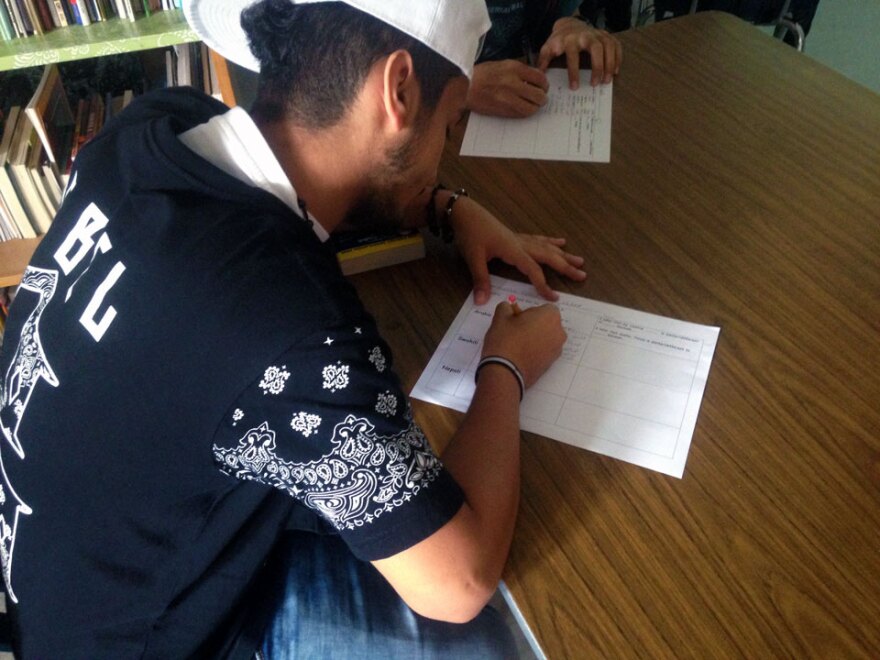For nearly five million students in the U.S., English isn’t their first language. In Austin ISD, some of those students are sent to a special school for international students, a school where dozens of languages are spoken. There, the idea is to help the students learn English before sending them back to their neighborhood high school. But something else happens as well.
Muath Farea is at a desk by himself, studying for his World History final. He’s writing in English, but that’s not his first language. Muath is from Saudi Arabia and just got to the states a few months ago. He wants to learn English quickly and go to college. All of his classmates are learning English, too, but Muath is one of the few who speaks Arabic.
Spanish dominates, he said, although he knows a few students in this class who are from Rwanda.
Students come to this school when they fail the state English test as a freshman or sophomore. After two years here, they’re sent back to their neighborhood high school.
The students are from all around the world – places like Burma, Iraq and Nepal – but the vast majority are from Honduras, Guatemala and other Central American countries.
"I’ll see kids from different countries actually hanging out together after school. They’re learning about each other just like any other teenager would. It’s just a little bit harder."
That means you still hear Spanish in the hallways and in the classrooms when students don’t understand something in English. And because so many students (and teachers) at this school speak Spanish, other students, including Muath, pick it up too.
"Hola, cómo estás? Bien," Muath said. "That means 'good.' 'Buenos días' is 'Good morning.'
Muath said sometimes speaking Spanish is the only way he can socialize with students whose English is still rusty. He said Arabic and Spanish can be pretty similar.
"You have some words in Spanish, with Arabic, it's the same," he said. "Like, 'sugar', in Arabic it's 'azucar'. In Spanish, too, azucar."
“I’ll see kids from different countries actually hanging out together after school," said Rosie Arrendondo, the school's counselor. "They’re learning about each other just like any other teenager would. It’s just a little bit harder.”
It’s harder because of language barriers, but she also sees students trying to teach each other their native languages.
"I've had a Vietnamese student think that a Salvadoran girl is very beautiful and want to talk to her, so he goes and tries to speak to her in Spanish to see if she'll give him her name," Arredondo said.
But when you’re trying to learn English, hearing Spanish at the same time can make it harder. Most of the students in Muath’s English class speak Spanish. The teacher, Brenda Townsend, flips back and forth between the two languages.
"What we're going to do today," Townsend intones to her class. "This is our final nota por la clase. The final grade for this class, okay?"
Muath said sometimes he gets tired of this Spanglish, especially when he wants to learn English first.
"That's confus[ing]," he says. "I can't focus if she speaks Spanish and after that I need focus for the English."
It’s a problem Townsend and other teachers at the school recognize. On this day, Townsend and a student go back and forth after a student calls out he wants her to speak in Spanish.
"No Spanish!" she said. "Every day you hear millions of Spanish."

Angela Hinz is another English teacher here. She hears from her non-Spanish speaking students about these extra language hurdles they face.
"And when they come to me and tell me, 'I'm tired of hearing all the Spanish,' I say, 'Right.' And I tell my students in my class, please be respectful. We have other students in the class. Please don't speak Spanish in the class, and I tell them it advances their English."
Hinz says, because there are so many Spanish-speaking students, they’ve got this huge comfort zone and it can take them longer to learn English than the other students. She says it's not a bad thing that most students speak Spanish, but it's frustrating for other, less fluent students.
"It's an invitation for you, too, to get curious about them," Hinz said she tells those students. "Not just to close the door and say, 'This is what they're doing to me,' but [to ask] 'How can I embrace them?' Because, when you embrace another culture, it opens up space for you to be included. You know, yeah, we have a lot of Spanish here, but there's a lot of learning that can take place with that."
Muath is taking advantage of that opportunity. Next year, he plans to take Spanish after school for extra high school credit.



